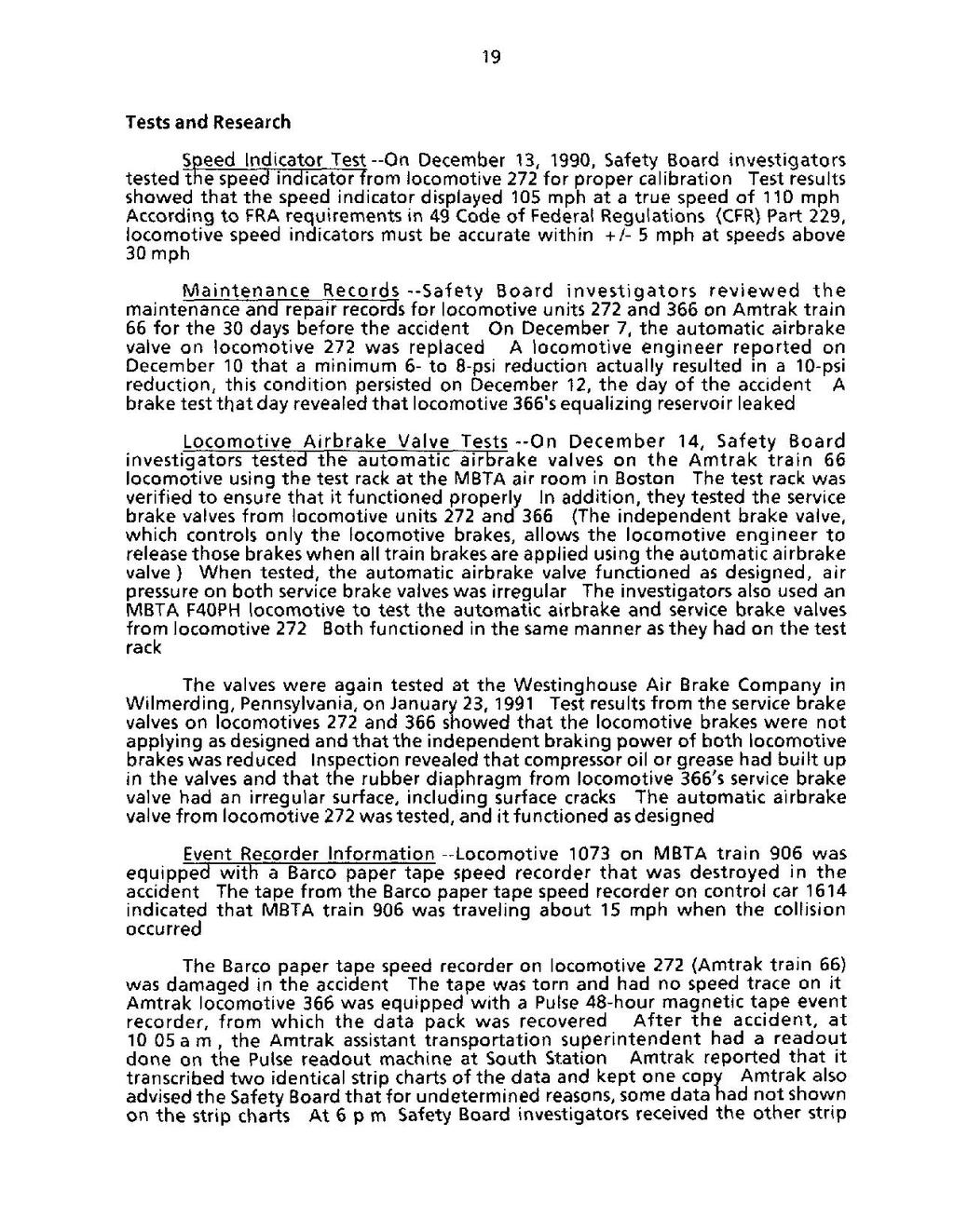19
Tests and Research
Speed Indicator Test—On December 13, 1990, Safety Board investigators tested the speed indicator from locomotive 272 for proper calibration. Test results showed that the speed indicator displayed 105 mph at a true speed of 110 mph. According to FRA requirements in 49 Code of Federal Regulations (CFR) Part 229, locomotive speed indicators must be accurate within +/- 5 mph at speeds above 30 mph.
Maintenance Records—Safety Board investigators reviewed the maintenance and repair records for locomotive units 272 and 366 on Amtrak train 66 for the 30 days before the accident. On December 7, the automatic airbrake valve on locomotive 272 was replaced. A locomotive engineer reported on December 10 that a minimum 6- to 8-psi reduction actually resulted in a 10-psi reduction, this condition persisted on December 12, the day of the accident. A brake test that day revealed that locomotive 366's equalizing reservoir leaked.
Locomotive Airbrake Valve Tests—On December 14, Safety Board investigators tested the automatic airbrake valves on the Amtrak train 66 locomotive using the test rack at the MBTA air room in Boston. The test rack was verified to ensure that it functioned properly. In addition, they tested the service brake valves from locomotive units 272 and 366. (The independent brake valve, which controls only the locomotive brakes, allows the locomotive engineer to release those brakes when all train brakes are applied using the automatic airbrake valve.) When tested, the automatic airbrake valve functioned as designed, air pressure on both service brake valves was irregular. The investigators also used an MBTA F40PH locomotive to test the automatic airbrake and service brake valves from locomotive 272. Both functioned in the same manner as they had on the test rack.
The valves were again tested at the Westinghouse Air Brake Company in Wilmerding, Pennsylvania, on January 23, 1991. Test results from the service brake valves on locomotives 272 and 366 showed that the locomotive brakes were not applying as designed and that the independent braking power of both locomotive brakes was reduced. Inspection revealed that compressor oil or grease had built up in the valves and that the rubber diaphragm from locomotive 366's service brake valve had an irregular surface, including surface cracks. The automatic airbrake valve from locomotive 272 was tested, and it functioned as designed.
Event Recorder Information—Locomotive 1073 on MBTA train 906 was equipped with a Barco paper tape speed recorder that was destroyed in the accident. The tape from the Barco paper tape speed recorder on control car 1614 indicated that MBTA train 906 was traveling about 15 mph when the collision occurred.
The Barco paper tape speed recorder on locomotive 272 (Amtrak train 66) was damaged in the accident. The tape was torn and had no speed trace on it Amtrak locomotive 366 was equipped with a Pulse 48-hour magnetic tape event recorder, from which the data pack was recovered. After the accident, at 10:05 a.m., the Amtrak assistant transportation superintendent had a readout done on the Pulse readout machine at South Station. Amtrak reported that it transcribed two identical strip charts of the data and kept one copy. Amtrak also advised the Safety Board that for undetermined reasons, some data had not shown on the strip charts. At 6 p.m. Safety Board investigators received the other strip
